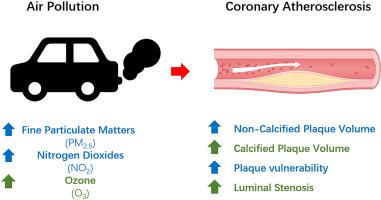Environmental Research ( IF 7.7 ) Pub Date : 2020-06-22 , DOI: 10.1016/j.envres.2020.109841 Zhi-Hui Hou 1 , Meng Wang 2 , Hao Xu 3 , Matthew J Budoff 4 , Adam A Szpiro 5 , Sverre Vedal 6 , Joel D Kaufman 6 , Bin Lu 1

|
Background
Exposure to ambient air pollution is associated with cardiovascular risk, potentially via atherosclerosis promotion. The disease mechanisms underlying these associations remain uncertain.
Objectives
We aim to investigate the relationship of air pollution and traffic proximity with subclinical atherosclerosis, using coronary plaque phenotypes to gain insight into potential mechanisms.
Methods
Coronary plaque total and component volumes, high-risk plaque (HRP) appearance, and luminal stenosis were characterized by coronary computed tomography angiography in 2279 patients with atherosclerosis at baseline between 2014 and 2017. Annual average exposure to air pollutants including fine particulate matter (PM2.5), nitrogen dioxide (NO2), and ozone (O3) was estimated by air pollution models for individual participants. Multiple linear regression models were used to assess the association of each exposure with plaque phenotypes and coronary stenosis, controlling for potential confounders. Multiple logistic regression models were used to estimate associations with plaque vulnerability.
Results
The studied population was 60.2±9.2 years old. PM2.5 and NO2 concentrations were significantly associated with a 5.0% (95%CI: 0.3, 9.9%, per 15 μg/m3 increase for PM2.5), 12.0% (95%CI: 2.5, 22.5% per 20 μg/m3 for NO2) larger volume of non-calcified plaque, respectively. Increase in O3 concentration was associated with a 12.2% (95%CI: 2.2, 23.2%, per 5 μg/m3 O3) larger volume of calcified plaque and a 12.8% (95%CI: 0.9, 26.2%) greater lumen narrowing. Increased PM2.5 and NO2, was also associated with increase in HRP, determined by the napkin ring sign (odds ratio: 1.41 [95%CI: 1.10, 1.80] for PM2.5 and 1.78 [95%CI: 1.20, 2.63] for NO2) and positive remodeling index (OR: 1.11 [95%CI: 1.01, 1.21] for PM2.5 and 1.20 [95%CI: 1.02, 1.42] for NO2), respectively, indicating increased plaque vulnerability.
Conclusion
Long-term exposures to air pollution were associated with greater plaque volume and luminal stenosis, and increased plaque vulnerability with attendant risk of plaque rupture and erosion.










































 京公网安备 11010802027423号
京公网安备 11010802027423号